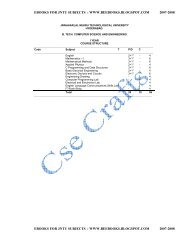Improving Student Writing Skills - cse crafts
Improving Student Writing Skills - cse crafts
Improving Student Writing Skills - cse crafts
You also want an ePaper? Increase the reach of your titles
YUMPU automatically turns print PDFs into web optimized ePapers that Google loves.
<strong>Improving</strong> <strong>Student</strong> <strong>Writing</strong> <strong>Skills</strong><br />
Therefore, strive to teach them universal editing marks<br />
that can be understood by everyone.<br />
• <strong>Student</strong>s Need Specifics<br />
“Children tend to overestimate their own and others’<br />
comprehension of text, and thus, they do not identify<br />
specific areas of text that could benefit from revision”<br />
(Beal, 1993, p. 643). At first, you may need to ask students<br />
to revise very specific elements (such as one of the Traits<br />
of Good <strong>Writing</strong>, as described in Chapter 4). Consider<br />
using mini lessons (in a writing workshop) to demonstrate<br />
revision of passages on an overhead. Once you have<br />
picked a revision topic, such as word choice, work as a<br />
class to revise the passage such that each student gains<br />
a picture of exactly what makes one word “better” than<br />
another. After demonstrating, ask students to apply the<br />
same technique in their own writing.<br />
• One Thing at a Time!<br />
Until students are proficient in noticing what needs revision,<br />
they should revise for only one issue at a time, likely<br />
one of the Traits of Good <strong>Writing</strong>. Perhaps on the first<br />
pass they will look only at their organization, and on the<br />
next they will evaluate their use of word choice, and so<br />
on. This will help students put specific language to their<br />
nagging idea that something isn’t quite right. As many<br />
of the traits are interrelated (disturbing a piece’s organization<br />
will affect sentence fluency), you may want to<br />
encourage students to revise in the following order: ideas,<br />
organization, word choice, voice, sentence fluency.<br />
• Make the Distinction Between Revising and<br />
Proofreading<br />
Revising is for content, while proofreading (editing) is<br />
for conventions (Reed, 1995). As long as the conventions<br />
used in a draft allow the material to be readable, your stu-<br />
56<br />
http://www.books-foru.blogspot.com




![JNTU ONLINE EXAMINATIONS [Mid 2 - JAVA] - cse crafts](https://img.yumpu.com/39435151/1/190x245/jntu-online-examinations-mid-2-java-cse-crafts.jpg?quality=85)
![JNTU ONLINE EXAMINATIONS [Mid 2 - ES] - cse crafts](https://img.yumpu.com/15318017/1/190x245/jntu-online-examinations-mid-2-es-cse-crafts.jpg?quality=85)
